Dream Wi-Fi. Or state of the art with radio frequencies
The theme of this topic will be Wi-Fi Nanostation modems, presented in Russia by Rapier as DreamWiFi. Or more precisely the question of the use of frequencies and registration. Well, as a nice bonus, under the cut, a review of these glands.

Despite the fact that Wi-Fi to some extent is already the technology of the last century and gives way to new, it comes in handy in two cases - the home network (intra office) and the organization of communication channels outdoors.
Here we will talk about the second case.
If everything is clear with intra-office use, then external channels require a great deal of attention, because this is obtaining permission to use radio frequencies - once, certified equipment (which you just can’t buy in a store) is two, and registration is three.
As you know, obtaining permission is an incredibly nervous and lengthy process. In the worst case, the organization of the channel may take more than a year (approvals, conclusions, field tests). Registration seems to be both a short and inexpensive procedure, but again bureaucratic red tape, communication with non-always loyal representatives of the supervisory authorities.
But what Dream Wi-Fi offers us:
But really, as it would be convenient, to notify the necessary structures and set without bothering about all these scrapes.
In support of Dream Wi-Fi, I was prompted by a document that spelled out the procedure for registering radio equipment (more precisely, sent to minkomsvjaz.ru ) and offered to fill out an application to register a Wi-Fi access point. The fact is that when installing a point with a radiated power of no more than 100 mW, taking into account the antenna gain outdoors, a simplified registration scheme operates through the site rsoc.ru. Subscriber stations at the same time do not need to register. Here I was pointed to:
On Amendments to the decision of the State Committee on Radio Frequency Protection on May 7, 2007 No. 07-20-03-001 “On the allocation of radio frequency bands to short-range devices” (decision of the State Committee on Radio Frequencies No. 09-05-09) http://minkomsvjaz.ru/ministry/ 170/174 / 8588.shtml
')
For Dream Wi-Fi, the support I was told in the web interface can be set to no more than 40 mW.
But a few, or rather, radically different situation was described to me in the local Roskomnadzor department; I was informed that this was a manufacturer’s speculation on the inaccuracies of the SCRF decision, and the employee No. 09-05-09 read it to me. In the state radio frequency center they said that there was no such thing at all, and immediately after installation and switching on, they would come to us, turn off all equipment and decently fine.
Where is the truth? I am somewhat confused and I hope that the publication will be read by people competent in this matter and will be able to comment.
For a new project to introduce high IT technologies in agriculture, we needed to provide a communication channel to the far-off lands. Cellular communication for incense breathes, operators refuse to E1, even Sibirtelecom can not give anything, not to mention the other * telecoms.
To help here we got the same Wi-Fi. The distance to the nearest point is about 4 km. Theoretically, for Wi-Fi is not a problem. It is only for the devices.
Without further ado, we ordered two sets of the above-mentioned Dream Wi-Fi modules.
Iron
So, the DWF2 kit consists of
1) Antennas with built-in Wi-Fi module:

2) Power supply and power cable.
3) Strepov for fastening to the pipe tube.
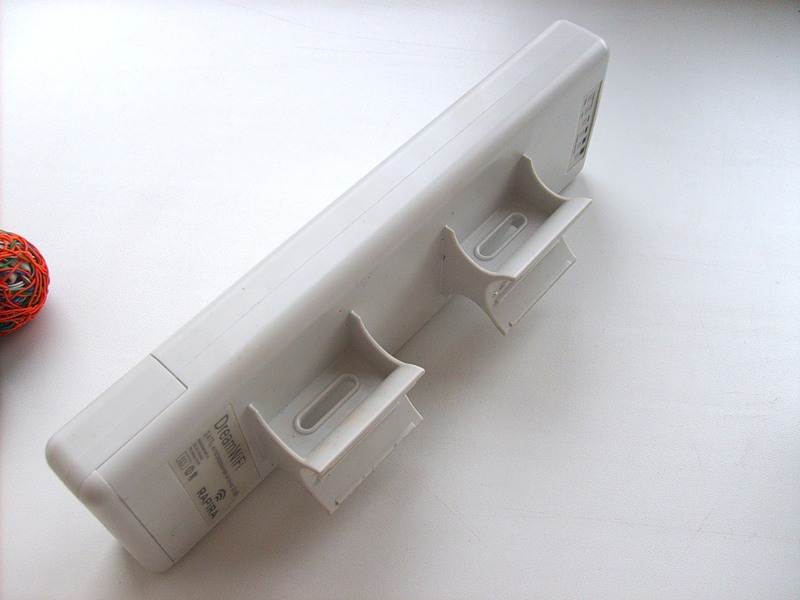
The antenna itself, as seen in the photo, is a candy bar with mounts on the back wall. Under the removable cover connector RG-45 and SMA for connecting an external antenna.
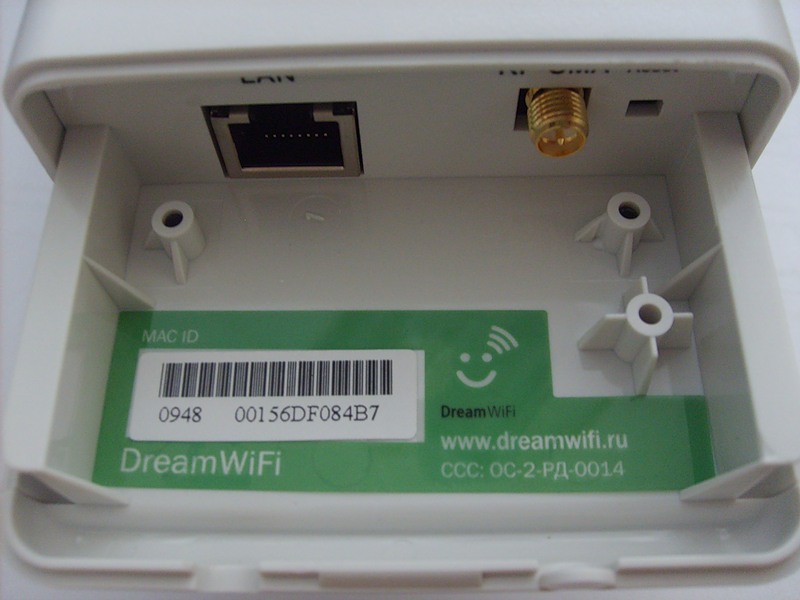
The antenna and the built-in module receive power through PoE, respectively, and on the power supply two RG-45 connectors: LAN and PoE. The connector for the external antenna is standard and finding a suitable jumper is easy. At the bottom there are two holes for the Ethernet cable and for the feeder, but since by default it is assumed that I will use the built-in antenna, the hole for the feeder is only marked, but not cut.
The power, LAN and signal strength indicators are located at the rear top, which is quite logical and thoughtful.
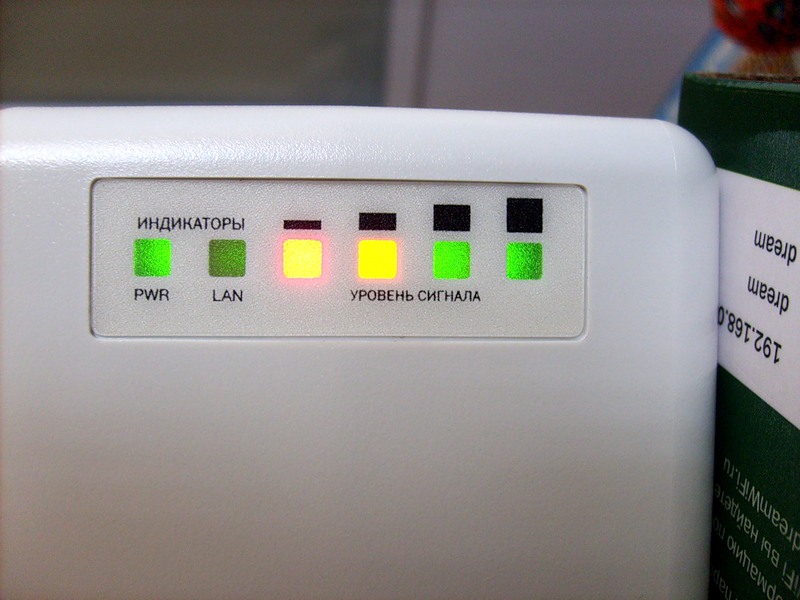
Of all that concerns the appearance and the iron part of the device, only three things worry:
1) Tightness of the lower compartment. For all other external devices, I saw a sealed RG-45 connector that fits tightly into the connector. But so far we have not had any problems with this. Also, moisture will be harmful in the case of connecting an external antenna.
2) Fastening on the strepes. In conditions of strong wind and constant temperature differences, this solution seems somewhat doubtful and I would prefer metal brackets or at least clamps.
3) Grounding. On the case of either the antenna or the power supply unit, I did not see the grounding terminals. And this is a critical moment for devices that will be placed at a height.
Web interface
The device came in a fun green box, on which there was an instruction for connecting, there were no manuals inside, not a single line.

But what should we build a house? The address is there, the access parameters are there - we'll deal with the rest.

No matter how wrong! The address given on the box (192.168.0.5) is not available. I try to take the address from the grid 192.168.1.0 and on the broadcast ping I get a response from the node 192.168.1.20. I score in the browser and see a window asking for a login / password. But again, the specified dream / dream does not fit. All other standard combinations are not suitable. Here, without the help of Google is not enough. And the last helpfully prompts: ubnt / ubnt. It turns out at some point they have changed the firmware and this has entailed changes of this kind. And really: the browser accepts such data and displays the admin panel.
Actually, the second group of questions: why not make the issuance of IP addresses via DHCP? Why not select the default address of 192.168.1.1 or 1.2 for devices? In my opinion, this is normal practice. And in the end, why not indicate actual data on the box or not attach a thin little book?
But leave. So, we are in the holy of holies Dream WiFi. A device can be an access point, a WDS access point, a subscriber station, or a WDS station. We need the usual point-to-point connection. One will be the access point, the other will be the client.
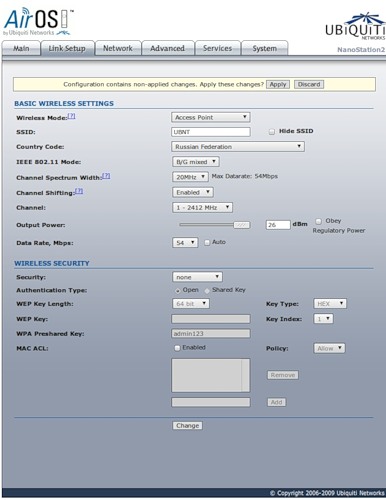

This is configured in the Link Setup panel. The setting is quite standard. There is a choice of channel width: 5/10/20 MHz. The frequency is manually tuned on both devices. Authentication modes supported: WEP, WPA2. They all work fine.
At the access point, you can add a list of MAC addresses of subscriber stations and set a rule for them: you can / cannot. At the subscriber station, you can set the MAC address of the access point to which it can connect.
Status view on the first panel. All parameters of the device are reflected here, including the signal level for the subscriber station:



On the Network Setup tab, you can configure the device operation mode (router / bridge), IP addresses, DHCP.

The next panel is specific settings. Here you can configure additional parameters of the wireless connection, antenna polarization (we are talking about external), rear panel indicator response thresholds, traffic shaping and QoS.
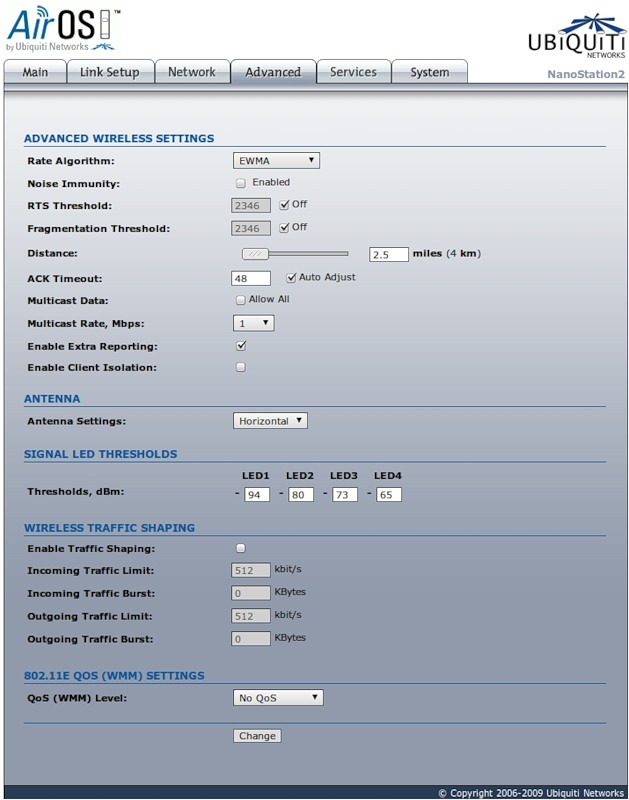
In the Service panel, the first group of settings scares: reboot after 3 unsuccessful ping attempts.

The web interface is the default management interface. Connection to the command line is closed. However, all the necessary settings can be made via the Web interface. As can be seen from the screenshots, it is quite logical and understandable, in addition, you can organize a secure connection via https.
Well, the last tab - the management of firmware, configuration, users. Everything is standard plus the ability to install any logo at the top of the page.

After making any changes, a warning appears at the top of the page stating that the changes should be applied or discarded. After clicking on the Apply button, as I understand it, Dream Wi-FI reboots. By the way, the download and connection time is very small - about a minute.
In general, an unusual decision that every change needs to be approved. This is somewhat non-standard if you are used to the fact that the settings are applied immediately to the running configuration. However, it is quite viable.
In general, with regard to the management interface, it turned out to be very convenient and consistent. Then I recall the interfaces of Zyxel switches or some WiMAX routers, which cannot be understood right away or even straight away.
Connection
Connecting is not difficult. From the opening of the box to connecting the 15 minutes. There were no problems either in the router mode or the bridge mode. But the throughput tests of the iperf program in the laboratory showed just around 20 Mb / s. For our purposes, this is in general more than enough, but nonetheless I would like to see the declared 54. In the laboratory, the devices were apart from each other at a distance of up to 5 meters.
Common words
The supplier's site is boring for a technical specialist: there are a lot of pictures and beautiful words, little information. It does not find any documentation or specifications. Looks like, rather, on a business card site. But contacts are - this is a necessary condition, albeit insufficient. Since I didn’t have much to communicate with, but the people there are quite helpful.
And once again I want to say about the package. Do not put at least some documentation and technical characteristics - this moveton, an even greater problem: the inconsistency of the information on the real box. I hope they pay attention to it.
Conclusion
So, despite all the above disadvantages, I would recommend this device to use. Of the alternatives, only LANTASTIK, RRL, the laying of its own optical channel, channel rental from other operators, and some self-assembly structures from office access points and antennas come to mind.
LANTASTIKA and other BOXES are a mass of tuning impressions for a lot more money.
RRL and installation of wired channels requires a very large investment, as well as a complex and lengthy procedure for obtaining permits.
Rent of communication channels again, rests on the economic feasibility, and a bonus dependence on third parties.
Although, of course, it all depends on the specific task. For the equipment described above there is a certain niche.

Despite the fact that Wi-Fi to some extent is already the technology of the last century and gives way to new, it comes in handy in two cases - the home network (intra office) and the organization of communication channels outdoors.
Here we will talk about the second case.
If everything is clear with intra-office use, then external channels require a great deal of attention, because this is obtaining permission to use radio frequencies - once, certified equipment (which you just can’t buy in a store) is two, and registration is three.
As you know, obtaining permission is an incredibly nervous and lengthy process. In the worst case, the organization of the channel may take more than a year (approvals, conclusions, field tests). Registration seems to be both a short and inexpensive procedure, but again bureaucratic red tape, communication with non-always loyal representatives of the supervisory authorities.
But what Dream Wi-Fi offers us:
For the 2.4 GHz DreamWiFi equipment, according to the decision of the State Committee for Radio Frequencies No. 09-05-09, the radio frequency center is not required to be approved by the military.
Access points are subject to simple, fast and free registration. Subscribers are not subject to registration.
But really, as it would be convenient, to notify the necessary structures and set without bothering about all these scrapes.
In support of Dream Wi-Fi, I was prompted by a document that spelled out the procedure for registering radio equipment (more precisely, sent to minkomsvjaz.ru ) and offered to fill out an application to register a Wi-Fi access point. The fact is that when installing a point with a radiated power of no more than 100 mW, taking into account the antenna gain outdoors, a simplified registration scheme operates through the site rsoc.ru. Subscriber stations at the same time do not need to register. Here I was pointed to:
On Amendments to the decision of the State Committee on Radio Frequency Protection on May 7, 2007 No. 07-20-03-001 “On the allocation of radio frequency bands to short-range devices” (decision of the State Committee on Radio Frequencies No. 09-05-09) http://minkomsvjaz.ru/ministry/ 170/174 / 8588.shtml
')
For devices with direct spectrum expansion at a spectral density of up to 2 mW / MHz (i.e. 40 mW for the 20 MHz band) and a maximum power of 100 mW. At the same time restrictions on the installation site - no "
For Dream Wi-Fi, the support I was told in the web interface can be set to no more than 40 mW.
But a few, or rather, radically different situation was described to me in the local Roskomnadzor department; I was informed that this was a manufacturer’s speculation on the inaccuracies of the SCRF decision, and the employee No. 09-05-09 read it to me. In the state radio frequency center they said that there was no such thing at all, and immediately after installation and switching on, they would come to us, turn off all equipment and decently fine.
Where is the truth? I am somewhat confused and I hope that the publication will be read by people competent in this matter and will be able to comment.
For a new project to introduce high IT technologies in agriculture, we needed to provide a communication channel to the far-off lands. Cellular communication for incense breathes, operators refuse to E1, even Sibirtelecom can not give anything, not to mention the other * telecoms.
To help here we got the same Wi-Fi. The distance to the nearest point is about 4 km. Theoretically, for Wi-Fi is not a problem. It is only for the devices.
Without further ado, we ordered two sets of the above-mentioned Dream Wi-Fi modules.
Iron
So, the DWF2 kit consists of
1) Antennas with built-in Wi-Fi module:

2) Power supply and power cable.
3) Strepov for fastening to the pipe tube.

The antenna itself, as seen in the photo, is a candy bar with mounts on the back wall. Under the removable cover connector RG-45 and SMA for connecting an external antenna.

The antenna and the built-in module receive power through PoE, respectively, and on the power supply two RG-45 connectors: LAN and PoE. The connector for the external antenna is standard and finding a suitable jumper is easy. At the bottom there are two holes for the Ethernet cable and for the feeder, but since by default it is assumed that I will use the built-in antenna, the hole for the feeder is only marked, but not cut.
The power, LAN and signal strength indicators are located at the rear top, which is quite logical and thoughtful.

Of all that concerns the appearance and the iron part of the device, only three things worry:
1) Tightness of the lower compartment. For all other external devices, I saw a sealed RG-45 connector that fits tightly into the connector. But so far we have not had any problems with this. Also, moisture will be harmful in the case of connecting an external antenna.
2) Fastening on the strepes. In conditions of strong wind and constant temperature differences, this solution seems somewhat doubtful and I would prefer metal brackets or at least clamps.
3) Grounding. On the case of either the antenna or the power supply unit, I did not see the grounding terminals. And this is a critical moment for devices that will be placed at a height.
Web interface
The device came in a fun green box, on which there was an instruction for connecting, there were no manuals inside, not a single line.

But what should we build a house? The address is there, the access parameters are there - we'll deal with the rest.

No matter how wrong! The address given on the box (192.168.0.5) is not available. I try to take the address from the grid 192.168.1.0 and on the broadcast ping I get a response from the node 192.168.1.20. I score in the browser and see a window asking for a login / password. But again, the specified dream / dream does not fit. All other standard combinations are not suitable. Here, without the help of Google is not enough. And the last helpfully prompts: ubnt / ubnt. It turns out at some point they have changed the firmware and this has entailed changes of this kind. And really: the browser accepts such data and displays the admin panel.
Actually, the second group of questions: why not make the issuance of IP addresses via DHCP? Why not select the default address of 192.168.1.1 or 1.2 for devices? In my opinion, this is normal practice. And in the end, why not indicate actual data on the box or not attach a thin little book?
But leave. So, we are in the holy of holies Dream WiFi. A device can be an access point, a WDS access point, a subscriber station, or a WDS station. We need the usual point-to-point connection. One will be the access point, the other will be the client.


This is configured in the Link Setup panel. The setting is quite standard. There is a choice of channel width: 5/10/20 MHz. The frequency is manually tuned on both devices. Authentication modes supported: WEP, WPA2. They all work fine.
At the access point, you can add a list of MAC addresses of subscriber stations and set a rule for them: you can / cannot. At the subscriber station, you can set the MAC address of the access point to which it can connect.
Status view on the first panel. All parameters of the device are reflected here, including the signal level for the subscriber station:



On the Network Setup tab, you can configure the device operation mode (router / bridge), IP addresses, DHCP.

The next panel is specific settings. Here you can configure additional parameters of the wireless connection, antenna polarization (we are talking about external), rear panel indicator response thresholds, traffic shaping and QoS.

In the Service panel, the first group of settings scares: reboot after 3 unsuccessful ping attempts.

The web interface is the default management interface. Connection to the command line is closed. However, all the necessary settings can be made via the Web interface. As can be seen from the screenshots, it is quite logical and understandable, in addition, you can organize a secure connection via https.
Well, the last tab - the management of firmware, configuration, users. Everything is standard plus the ability to install any logo at the top of the page.

After making any changes, a warning appears at the top of the page stating that the changes should be applied or discarded. After clicking on the Apply button, as I understand it, Dream Wi-FI reboots. By the way, the download and connection time is very small - about a minute.
In general, an unusual decision that every change needs to be approved. This is somewhat non-standard if you are used to the fact that the settings are applied immediately to the running configuration. However, it is quite viable.
In general, with regard to the management interface, it turned out to be very convenient and consistent. Then I recall the interfaces of Zyxel switches or some WiMAX routers, which cannot be understood right away or even straight away.
Connection
Connecting is not difficult. From the opening of the box to connecting the 15 minutes. There were no problems either in the router mode or the bridge mode. But the throughput tests of the iperf program in the laboratory showed just around 20 Mb / s. For our purposes, this is in general more than enough, but nonetheless I would like to see the declared 54. In the laboratory, the devices were apart from each other at a distance of up to 5 meters.
Common words
The supplier's site is boring for a technical specialist: there are a lot of pictures and beautiful words, little information. It does not find any documentation or specifications. Looks like, rather, on a business card site. But contacts are - this is a necessary condition, albeit insufficient. Since I didn’t have much to communicate with, but the people there are quite helpful.
And once again I want to say about the package. Do not put at least some documentation and technical characteristics - this moveton, an even greater problem: the inconsistency of the information on the real box. I hope they pay attention to it.
Conclusion
So, despite all the above disadvantages, I would recommend this device to use. Of the alternatives, only LANTASTIK, RRL, the laying of its own optical channel, channel rental from other operators, and some self-assembly structures from office access points and antennas come to mind.
LANTASTIKA and other BOXES are a mass of tuning impressions for a lot more money.
RRL and installation of wired channels requires a very large investment, as well as a complex and lengthy procedure for obtaining permits.
Rent of communication channels again, rests on the economic feasibility, and a bonus dependence on third parties.
Although, of course, it all depends on the specific task. For the equipment described above there is a certain niche.
Source: https://habr.com/ru/post/104849/
All Articles